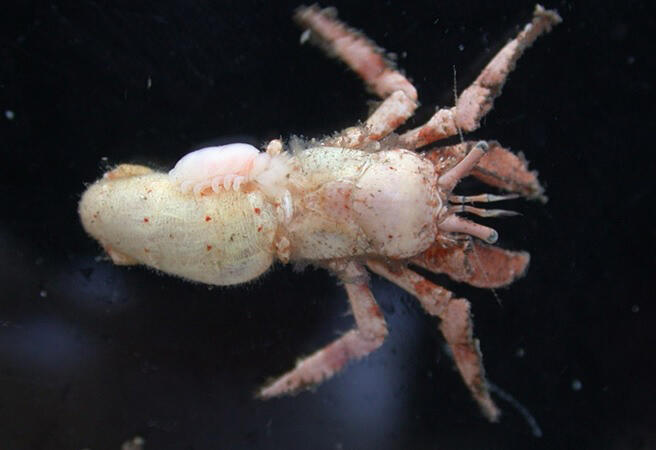Members of the subfamily Athelginae constitute a group of isopods, which include the terrestrial wood louse and marine giant isopods. Adults of the species in this subfamily are parasitic of hermit crabs. The parasitic bopyrid isopods attach themselves to the host abdomen using their legs in a supine position and suck host body fluids to obtain nutrients. In the subfamily Athelginae, three genera and four species from Japan have been reported. The last record of the subfamily Athelginae from Japan involved two new species described by Dr. Sueo Shiino in 1950.
A research group including Graduate Student Haruki Shinoda, PD Research Fellow Hiroki Fujita, Associate Professor Tomoyuki Nakano, and Professor Michitaka Shimomura of the Field Science Education and Research Center at Kyoto University discovered a species of parasitic isopod of the subfamily Athelginae on the abdomen of the hermit crab Cancellus mayoae collected at 163-167 m depth near Amami-Oshima Island. After a detailed morphological examination, they named it Falsanathelges grandiceps (Japanese name: Yakkoyadokari-no-harayadori) and reported it as a new species. The new species F. grandiceps was named after combining the Latin words "grandi" and "ceps," meaning "large" and "head," respectively, because its head is very large for its body size. The Japanese name is derived from the fact that it is an abdominal bopyrid parasite of C. mayoae (Japanese name: Yakkoyadokari). This is the first new species of the subfamily Athelginae from Japan in 75 years and the first species of the genus Falsanathelges found there. The study was published in Zootaxa.

Provided by Kyoto University
The research group closely examined the morphology of a species of the subfamily Athelginae, which was found as an abdominal bopyrid parasite of C. mayoae collected from the seafloor near Amami-Oshima Island in 2003 using the Hiroshima University's training vessel "Toyoshio-maru." They identified it as a Falsanathelges species based on the absence of space among the fourth to seventh pereopods and the presence of biramous pleopods and unilobed pleura on the first to fifth abdominal segments.
They described F. grandiceps as a new species because it could be distinguished from existing species based on several characteristics. These include no bendability of pereonites in females, the diameter of the head longer than its width and one-fourth of the body length in females, the head anterior margin convex anteriorly in females, pereopods without large lobe in females, two pairs of uropods without a peduncle, and a pair of chaetal bundles at the pleon posterior end in males. Because some traits were not consistent with the previously known traits of the genus, they redefined the generic traits.
The number of species of the subfamily Athelginae from Japan was lower compared to the number of species of other parasitic isopods, and their diversity was underestimated. The first discovery of a member of this genus from Japan in this study shed light on the high diversity of the subfamily Athelginae. Further taxonomic studies are warranted.
Shinoda said, "This was the first time I submitted a paper for publication, so I had a series of problems, but thanks to the support from many people, I was able to publish this paper. I hope many people will learn that an organism like this one parasitizes hermit crabs."
Journal Information
Publication: Zootaxa
Title: First record of Falsanathelges Boyko & Williams, 2003 (Crustacea: Isopoda: Epicaridea: Bopyridae) from Japan, with the description of a new species
DOI: 10.11646/zootaxa.5594.1.7
This article has been translated by JST with permission from The Science News Ltd. (https://sci-news.co.jp/). Unauthorized reproduction of the article and photographs is prohibited.




